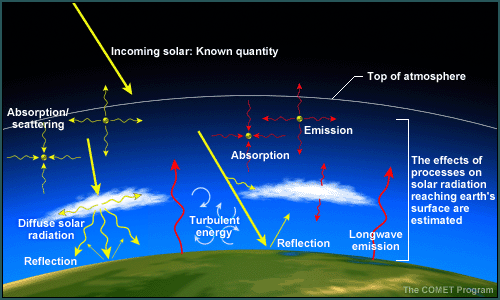* Model Emulation of Radiation

We know the amount of incoming solar energy at the top of the atmosphere at diurnal, synoptic, and short-range climate timescales. But uncertainties arise in emulating the effects of the atmosphere and earth's surface on incoming solar and outgoing terrestrial radiation, which involves the following:
- In the atmosphere
- Transmission/Absorption
- Reemission (for atmospheric longwave radiation)
- Reflection
- Scattering
- At the earth's surface
- Transformation from shortwave into other forms of energy at the earth's surface, based on the state of that surface over the area covered by the model grid box
- Net emission of longwave radiation from the earth's surface toward space
These uncertainties exist because:
- we can only crudely emulate the effects of the atmosphere and its constituents (for example, clouds, aerosols, and absorbing gases) on the incoming solar beam and outgoing terrestrial/longwave radiation;
- we can only estimate the state of the land and sea surface in models and its effects on the absorption and subsequent conversion of incoming shortwave radiation into other forms of energy.
- The real world data needed to fine-tune the emulation of land and sea surface physics (for example, soil moisture and surface fluxes) are incomplete.
Even if a radiation model were perfect, model forecasts would be subject to errors in:
- initial analyses of moisture and cloudiness
- predicting the location and thickness of clouds
- predicting the amount of moisture, aerosols, and trace gases in the atmosphere
- analyzing, predicting, and/or prescribing the land and/or ocean surface state